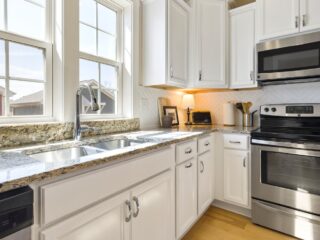When it comes to discussing the differences between an apartment and a condominium, the two terms are often used interchangeably. While there are some similarities between the two terms, there are more distinct differences that are important to understand. In this article, we will examine the key differences between an apartment and a condominium and how they affect the occupants:
- Ownership – In an apartment, the tenant is only renting the space while the landlord owns the property. In a condominium, the occupant owns the unit and the building is jointly owned by all of the unit owners.
- Maintenance – In an apartment, the landlord is responsible for all of the maintenance, repairs and upkeep of the building. In a condominium, the unit owners are responsible for maintaining their own unit and contributing to the shared costs of maintaining the building.
- Amenities – Apartments typically have fewer amenities than condominiums. Condominiums may offer access to a pool, fitness center, clubhouse and other amenities that are not available in an apartment.
Definition of apartment and condominium
Understanding the difference between an apartment and a condominium can be difficult. An apartment is a rental unit that may be part of a larger building or complex owned by an individual or a rental company. A condominium is similar to an apartment, but the owner actually has legal title to the unit and can sell it on the open market at any time.
An apartment lease typically includes specific rules outlined by the landlord that tenants must adhere to, including occupancy limits, noise levels, security deposits, pet restrictions, and more. A condominium lease involves many of these same restrictions but also allows for ownership privileges such as equity ownership and independent decision making related to improvements and maintenance on their individual condo unit.
When renting either of these types of residences it’s important to restate your understanding during or after signing a lease agreement so that you understand your rights as a tenant and how long your occupation will last. Additionally, in some cases landlords may require tenants to carry renters’ insurance in order to protect against any property damage or injuries incurred during occupancy. Knowing what you’re getting when leasing property is essential in ensuring that all parties are on the same page when it comes to enforcement-related situations.
What is the difference between an apartment and a condominium
Determining the differences between an apartment and a condominium is key to making an informed decision when it comes to buying or renting a home. One of the most important differences lies in how ownership works between the two. Apartments are typically managed by an owner or management company while condominiums are owned by individuals who have to comply with the rules and regulations of an association.
Let’s look at the differences in ownership of an apartment and a condominium in more detail:
Ownership of apartment
When most people think of an apartment, they usually are referring to rental units where the resident does not have ownership of the unit itself. This type of occupancy is referred to as a tenancy and the resident is responsible for their share of rent, repairs and maintenance. A tenant has limited rights in regard to property, unless it is stated in a lease or setting forth established rights required by law.
The property manager or landlord will handle things such as repairs and maintenance along with bills related to common areas used by tenants. The landlord holds the title to the property, meaning they own it and can determine how it can be used.
Sometimes a landlord may allow tenants in an apartment complex to purchase their individual units at an agreed upon price. This would transfer ownership from the landlord to them and make them homeowners instead of renters. It is important for everyone involved to be aware that this would highly impact both parties’ legal rights related to the property.
Ownership of condominium
Owning a condominium is typically done by purchasing a deed to the unit that is held by the homeowner in the form of real estate. Owners of a condo have exclusive rights and ownership to their assigned condo, including all features and fixtures inside their unit, such as all walls, floors, cabinets and built-in appliances. The boundary is everything from the midline wall inwards.
In addition to what lies within their individual perimeters, condominium owners also own portions of common areas within the condo development. These common areas are owned by every member of the homeowners association (HOA) on a pro rata basis. This means that when one owner sells his or her condo, he or she actually sells some portion of the common area as well – which is distributed pro rata amongst all remaining HOA members through assessments and/or an HOA fee structure.
Differences in Amenities
When discussing the differences between an apartment and a condominium, one of the most common points of comparison is the amenities available in each. Both apartments and condominiums can have amenities such as a gym and a pool, but in general, condominiums tend to have a more extensive list of offerings. This section will take a closer look at the differences in amenities between an apartment and a condominium.
Amenities offered in an apartment
Apartments generally offer basic amenities, as well as ones that are tailored to residents of the building. These services can include security, emergency maintenance, and trash removal. Other common services and amenities offered in an apartment may include high-speed internet access or cable television, pools or fitness centers, recreational areas and walking trails, a library or study center, onsite laundry facilities or dry cleaning valet service, gated entries and parking garages with carports.
Residents of apartments may receive discounts at local stores through their leasing office. Apartments usually come with either carpeting or hardwood floors depending on the unit’s level of luxury.
Apartments will generally also provide concierge services such as package delivery acceptance and pet walking request assistance. On top of these amenities tenants have access to a community lounge which is typically furnished with couches, tables and chairs for gathering with family and friends. This can be a great place to host parties if there is no additional fee for its use directly from the leasing office. Apartment complexes may also include pools to reinforce the sense of community among tenants who live there full time.
Amenities offered in a condominium
Aside from differences in ownership and legal considerations, apartments and condominiums can also differ in the amenities and services that are made available to their tenants. When it comes to amenities, condominiums often offer more than apartments.
In most cases, condominium owners have access to a variety of amenities such as swimming pools, tennis courts, fitness centers, party rooms and parking areas. Many condos are even equipped with on-site restaurants and stores. Condominium communities will usually have security personnel as well as landscaping services taken care of by the association.
Generally speaking, apartments will only provide basic services such as a maintenance staff and may not have certain on-site amenities available; however they could be available within the vicinity of surrounding neighborhoods.
Differences in Maintenance
When deciding between an apartment and a condominium, one of the biggest differences between the two is maintenance. Apartments typically come with a landlord that takes care of most of the maintenance, while condominiums require more of the maintenance responsibility to be taken on by the owner.
Let’s explore how maintenance responsibilities differ between the two living arrangements:
Maintenance of an apartment
The maintenance of an apartment is usually managed by the landlord, who is responsible for any necessary repairs that arise throughout the duration of a tenant’s lease. Routine maintenance and upkeep, such as changing light bulbs and fixing plumbing issues, are often attended to quickly by the landlord. Generally, tenants can expect prompt service, provided that they notify their landlords in a timely manner.
Some apartments may come with cleaning services or other amenities included in their rent payment.
In contrast to an apartment building, condominiums and townhomes typically require their owner-occupants to handle their own maintenance needs. While repairs and upkeep must still fall within local regulations and area ordinances, individual homeowners are ultimately responsible for handling the repair of issues within the premises. Homeowners may collaborate with neighbors to take on larger tasks or opt to hire people individually for specific jobs as needed.
Maintenance of a condominium
When considering purchasing a home, there is a big difference between an apartment and a condominium. One of the differences lies in who does the maintenance of buildings and common areas.
In an apartment building, it is the responsibility of the landlord or manager to keep up with all maintenance issues that exist in property common areas, such as hallways and stairways. If there are flaws or visible signs of age in these conditions, it is up to them to recognize those repairs needed soonest.
With a condominium complex, however, this responsibility rests not with the property owner but with each individual homeowner via some form of association within the complex. This association will collect dues from each homeowner to pay for necessary maintenance including:
- Landscaping activities like mowing grass or clearing snow
- More serious issues such as roof repair or plumbing needs
This responsibility may also extend beyond regular maintenance tasks to extra amenities sometimes offered by condominium complexes like a swimming pool or clubhouse – though fees for these additional services may be separate from fees associated with basic upkeep.
Conclusion
In conclusion, the main difference between an apartment and a condominium is ownership. Apartments are owned by a landlord while condominiums are owned by the unit owners. Apartments also usually include facilities such as swimming pools, gyms and other amenities that are maintained by the landlord while condominiums do not typically have these amenities included in their ownership structure.
While both can be great places to live, it is important to research and understand the differences so you can make an informed decision about where you’ll be living.







